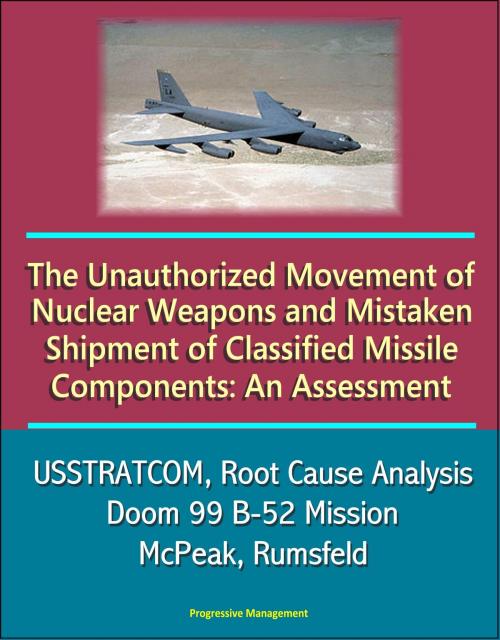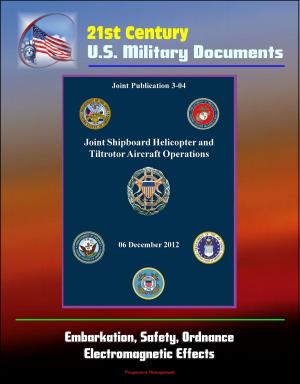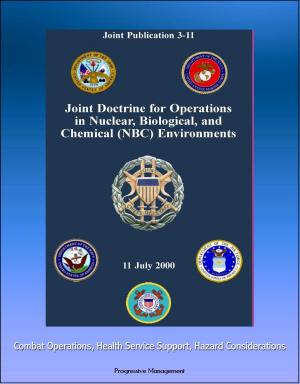The Unauthorized Movement of Nuclear Weapons and Mistaken Shipment of Classified Missile Components: An Assessment - USSTRATCOM, Root Cause Analysis, Doom 99 B-52 Mission, McPeak, Rumsfeld
Nonfiction, History, Military, Nuclear Warfare| Author: | Progressive Management | ISBN: | 9781310184475 |
| Publisher: | Progressive Management | Publication: | May 9, 2014 |
| Imprint: | Smashwords Edition | Language: | English |
| Author: | Progressive Management |
| ISBN: | 9781310184475 |
| Publisher: | Progressive Management |
| Publication: | May 9, 2014 |
| Imprint: | Smashwords Edition |
| Language: | English |
On August 31, 2007, a U.S. Air Force B-52 plane with the call sign "Doom 99" took off from Minot Air Force Base (AFB), North Dakota, inadvertently loaded with six Advanced Cruise Missiles loaded with nuclear warheads and flew to Barksdale AFB, Louisiana. After landing, "Doom 99" sat on the tarmac at Barksdale unguarded for nine hours before the nuclear weapons were discovered. While the Air Force was reeling from the investigations of the unauthorized movement of nuclear weapons, it was revealed that Taiwan had received classified forward sections of the Minuteman III intercontinental ballistic missile rather than the helicopter batteries it had ordered from the U.S., bringing to light a second nuclear-related incident.
This report is the result of a year-long Air University research project funded by Headquarters Air Force (HAF), Strategic Deterrence and Nuclear Integration (A10). The study team was tasked with researching and writing a case study to investigate how the Air Force can reinvigorate the handling, operation, and maintenance discipline of nuclear weapons that characterized nuclear operations standards and culture at the height of the Cold War. The goal of the study was to provide a deeper understanding of the context of internal and external forces that led to the unauthorized movement of nuclear weapons and mistaken shipment of classified forward sections. The methodology was to: conduct a literature review of existing studies, reports, policies, and procedures; hold workshops to review direction and findings, both at the operational and senior leadership levels; and conduct interviews with senior Air Force, Department of Defense (DoD) and national security experts who played a role in our nuclear mission between 1986 to the present.
Our research led to the conclusion that while the events of 2006-2007 are significant in and of themselves, the unauthorized movement of nuclear weapons and mistaken shipment of classified forward sections are merely symptoms of greater institutional problems.
Study Findings * DEFINING THE PROBLEM * Leadership * Management * Expertise * HISTORY * The Deterrence Mission * Organization and Culture of SAC * Air Force Organization and Missions * Comparing Air Force and Navy Nuclear Operations * The Demise of the Soviet Union and SAC * ROOT CAUSE 1: POLICY AND OVERSIGHT CHANGES * Strategy and Policy * The Power of the Atom and the Aging Scientific Community * Congress * Arms Control Reduces Bureaucratic Clout * ROOT CAUSE 2: ORGANIZATIONAL CHANGE AND OPERATIONAL EVOLUTION * Office of the Secretary of Defense * USSTRATCOM and Headquarters Air Force * Nuclear Goes Conventional * General McPeak's Revolution * Goldwater-Nichols Overhauls Service Structure * ROOT CAUSE 3: INSTITUTIONAL FOCUS * Signs of Nuclear Enterprise Decline Were Ignored * Air Force Cultures of Compliance and Self-Assessment Are Gone * Nuclear Education and Training De-emphasized * ROOT CAUSE 4: FAILURE OF LEADERSHIP * Nuclear Weapons Lose Their Advocates * Inaction Can Be As Harmful As Action * ROOT CAUSE 5: FAILURE TO FOCUS EXPERTISE * Nuclear Weapons are a "Sunset Business" * Loss of Intellectual Capital * Every Airman a Leader? * RECOMMENDATIONS * Expertise * Put the Nuclear Mission Back into the Hands of the "Experts" * Reestablish Operational Competence * Incentivize Change and Ensure Retention * Leadership * Reinstitute Core Principles: Communication and Responsibility * Motivate Managers to Be Leaders * Require Responsibility at the Highest Levels * Management * Enable Nuclear Staff to Learn From Past and Focus on the Future * Reinstitute Unity of Command * Make Change Work * Culture * Reestablish the Culture of Excellence * Explain Why the Mission is Vital * Inform Up; Educate Down
On August 31, 2007, a U.S. Air Force B-52 plane with the call sign "Doom 99" took off from Minot Air Force Base (AFB), North Dakota, inadvertently loaded with six Advanced Cruise Missiles loaded with nuclear warheads and flew to Barksdale AFB, Louisiana. After landing, "Doom 99" sat on the tarmac at Barksdale unguarded for nine hours before the nuclear weapons were discovered. While the Air Force was reeling from the investigations of the unauthorized movement of nuclear weapons, it was revealed that Taiwan had received classified forward sections of the Minuteman III intercontinental ballistic missile rather than the helicopter batteries it had ordered from the U.S., bringing to light a second nuclear-related incident.
This report is the result of a year-long Air University research project funded by Headquarters Air Force (HAF), Strategic Deterrence and Nuclear Integration (A10). The study team was tasked with researching and writing a case study to investigate how the Air Force can reinvigorate the handling, operation, and maintenance discipline of nuclear weapons that characterized nuclear operations standards and culture at the height of the Cold War. The goal of the study was to provide a deeper understanding of the context of internal and external forces that led to the unauthorized movement of nuclear weapons and mistaken shipment of classified forward sections. The methodology was to: conduct a literature review of existing studies, reports, policies, and procedures; hold workshops to review direction and findings, both at the operational and senior leadership levels; and conduct interviews with senior Air Force, Department of Defense (DoD) and national security experts who played a role in our nuclear mission between 1986 to the present.
Our research led to the conclusion that while the events of 2006-2007 are significant in and of themselves, the unauthorized movement of nuclear weapons and mistaken shipment of classified forward sections are merely symptoms of greater institutional problems.
Study Findings * DEFINING THE PROBLEM * Leadership * Management * Expertise * HISTORY * The Deterrence Mission * Organization and Culture of SAC * Air Force Organization and Missions * Comparing Air Force and Navy Nuclear Operations * The Demise of the Soviet Union and SAC * ROOT CAUSE 1: POLICY AND OVERSIGHT CHANGES * Strategy and Policy * The Power of the Atom and the Aging Scientific Community * Congress * Arms Control Reduces Bureaucratic Clout * ROOT CAUSE 2: ORGANIZATIONAL CHANGE AND OPERATIONAL EVOLUTION * Office of the Secretary of Defense * USSTRATCOM and Headquarters Air Force * Nuclear Goes Conventional * General McPeak's Revolution * Goldwater-Nichols Overhauls Service Structure * ROOT CAUSE 3: INSTITUTIONAL FOCUS * Signs of Nuclear Enterprise Decline Were Ignored * Air Force Cultures of Compliance and Self-Assessment Are Gone * Nuclear Education and Training De-emphasized * ROOT CAUSE 4: FAILURE OF LEADERSHIP * Nuclear Weapons Lose Their Advocates * Inaction Can Be As Harmful As Action * ROOT CAUSE 5: FAILURE TO FOCUS EXPERTISE * Nuclear Weapons are a "Sunset Business" * Loss of Intellectual Capital * Every Airman a Leader? * RECOMMENDATIONS * Expertise * Put the Nuclear Mission Back into the Hands of the "Experts" * Reestablish Operational Competence * Incentivize Change and Ensure Retention * Leadership * Reinstitute Core Principles: Communication and Responsibility * Motivate Managers to Be Leaders * Require Responsibility at the Highest Levels * Management * Enable Nuclear Staff to Learn From Past and Focus on the Future * Reinstitute Unity of Command * Make Change Work * Culture * Reestablish the Culture of Excellence * Explain Why the Mission is Vital * Inform Up; Educate Down















